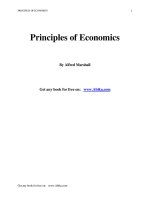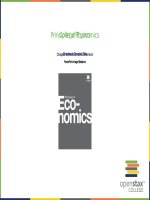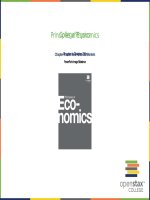Principles of economics openstax chapter8
Bạn đang xem bản rút gọn của tài liệu. Xem và tải ngay bản đầy đủ của tài liệu tại đây (564.41 KB, 17 trang )
College
Principles
ofPhysics
Economics
Chapter
# Chapter
Title
Chapter
8 Perfect
Competition
PowerPoint Image Slideshow
family farming
Depending upon the competition and prices offered, a wheat farmer may choose to grow
a different crop.
Characteristics of Perfect Competition
A large number of firms in the market such that no one can influence the
price
The firm sells a good identical to those sold by other firms
Firms have reliable sales and cost forecasts
There is no legal or economic barrier to enter into or exit from the market
Firm’s Objective
Profit maximization – To make the largest amount of profit possible
Total Revenue = Price*Quantity
Total Cost = Average Cost*Quantity
Total Profit = TR - TC
Firm’s Objective
Total revenue for a perfectly competitive firm is a straight line sloping up. The slope
is equal to the price of the good.
Total cost also slopes up, but with some curvature. At higher levels of output, total
cost begins to slope upward more steeply because of diminishing marginal returns.
The maximum profit will occur at the quantity where the gap of total revenue over
total cost is largest.
Profit maximization
Marginal Revenue-Marginal Cost Rule
MR is a horizontal straight line because it is equal to the price of the good, which is
determined by the market.
MC is U-shaped: division of labor causing MC to fall, but diminishing return forcing
MC to rise
Profit maximization requires MR = MC.
Since P = MR, then P = MC.
Figure 8.3
Market Equilibrium
The equilibrium price of raspberries is determined through the interaction of market supply and
market demand at $4.00.
Firm’s profitability
In panel (a), P = MC, but P > AC. Thus TR > TC and firm makes profit.
In panel (b), P = MC, and P = AC. Thus TR = TC and firm breaks even.
In panel (c), P = MC, but P < AC. Thus TR < TC and firm operates with a loss.
Firm’s profitability
Firm’s operation decision
In panel (a), P = MC, but AVC < P < AC. Firm operates with a loss < TFC. It
continues to operate, expecting price to rise.
In panel (b), P = MC, but P < AVC. Firm operates with a loss > TFC. It must shutdown.
Firm’s operation decision
Firm’s operation decision
Break-even point:
P = MC and P = AC. Firm operates with zero profit since TR = TC.
Shut-down point:
P = MC, but P = AVC. Firm operates with a loss = TFC. It stays open if expects price
to rise.
Firm’s operation decision
Changing market conditions
In panel (a), Increase in demand = Increase in supply: quantity increases, but price
stays the same
In panel (b), Increase in demand > Increase in supply: quantity increases and price
rises
In panel (c), Increase in demand < Increase in supply: quantity increases, but price
falls
Changing market conditions









